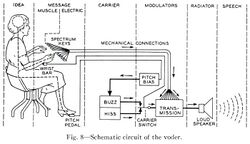Voder
The Bell Telephone Laboratory's Voder (from Voice Operating Demonstrator) was the first attempt to electronically synthesize human speech by breaking it down into its acoustic components. It was invented by Homer Dudley in 1937–1938 and developed on his earlier work on the vocoder. The quality of the speech was limited; however, it demonstrated the synthesis of the human voice, which became one component of the vocoder used in voice communications for security and to save bandwidth.[1]

The Voder synthesized human speech by imitating the effects of the human vocal tract. The operator could select one of two basic sounds by using a wrist bar. A buzz tone generated by a relaxation oscillator produced the voiced vowels and nasal sounds, with the pitch controlled by a foot pedal. A hissing noise produced by a white noise tube created the sibilants (voiceless fricative sounds). These initial sounds were passed through a bank of 10 band-pass filters that were selected by keys; their outputs were combined, amplified and fed to a loudspeaker. The filters were controlled by a set of keys and a foot pedal to convert the hisses and tones into vowels, consonants, and inflections. Additional special keys were provided to make the plosive sounds such as "p" or "d", and the affricative sounds of the "j" in "jaw" and the "ch" in "cheese". This was a complex machine to operate. After months of practice, a trained operator could produce recognizable speech.[1]
thumb|Voder demonstration by Bell Labs at the [[1939 New York World's Fair[3]]]
Performances on the Voder were featured at the 1939 New York World's Fair and in San Francisco. Twenty operators were trained by Helen Harper, particularly noted for her skill with the machine. The machine said the words "Good afternoon, radio audience."[4]
The Voder was developed from research into compression schemes for transmission of voice on copper wires and for voice encryption. In 1948, Werner Meyer-Eppler[5] recognized the capability of the Voder machine to generate electronic music, as described in Dudley's patent.
Whereas the vocoder analyzes speech, transforms it into electronically transmitted information, and recreates it, the voder generates synthesized speech by means of a console with fifteen touch-sensitive keys and a pedal. It basically consists of the "second half" of the vocoder, but with manual filter controls, and requires a highly trained operator.[6][7]
See also
References
- ↑ 1.0 1.1 Ben Gold, Nelson Morgan, Dan Ellis, Speech and Audio Signal Processing: Processing and Perception of Speech and Music. John Wiley & Sons, 2011; ISBN:1118142918, pages 9‒13
- ↑ Bell System Technical Journal 1940, p. 509, Fig.8 Schematic circuit of the voder
- ↑ Bell Telephone Quarterly 1940, p. 65, "At the New York World's Fair", THE VODER FASCINATES THE CROWDS - "The manipulative skill of the operator's fingers makes the Voder's voice almost too good to be true"
- ↑ Guernsey, Lisa (August 9, 2001). "The Desktop That Does Elvis". The New York Times. https://www.nytimes.com/2001/08/09/technology/the-desktop-that-does-elvis.html. "At the 1939 World's Fair in New York City, AT&T Bell Laboratories, a forerunner of AT&T Labs, unveiled a speech machine called the Voder. Six women were trained to operate the contraption, which was played like a pipe organ. When the machine said, "Good afternoon, radio audience," it sounded like an alien speaking under water."
- ↑ Diesterhöft, Sonja (2003), "Meyer-Eppler und der Vocoder" (in de), Seminars Klanganalyse und -synthese (Fachgebiet Kommunikationswissenschaft, Institut für Sprache und Kommunikation, Berlin Institute of Technology), archived from the original on 2008-03-05, https://web.archive.org/web/20080305021509/http://www.kgw.tu-berlin.de/statisch/Studio/Meyer-Eppler/Meyer-Eppler.html
- ↑ "Wendy Carlos Vocoder Q&A". Wendy Carlos. http://www.wendycarlos.com/vocoders.html.
- ↑ "Homer Dudley's Speech Synthesisers, "The Vocoder" (1940) & "Voder"(1939)". Electronic Musical Instrument 1870–1990. 120 Years of Electronic Music (120years.net). http://120years.net/machines/vocoder/.
- Bibliography
- Dudley, Homer (October 1940). "The Carrier Nature of Speech". Bell System Technical Journal XIX (4): 495–515. https://archive.org/stream/bellsystemtechni19amerrich/bellsystemtechni19amerrich#page/495/mode/1up. "Speech synthesizing is here discussed in the terminology of carrier circuits. ...".
- Williams, Thomas W. (January 1940). "At the New York World's Fair". Bell Telephone Quarterly (New York: American Telephone & Telegraph Co.) XIX (1): 59–71. https://archive.org/stream/belltelephonemag19amerrich/belltelephonemag19amerrich#page/59/mode/1up. "More than Thirteen Million Visitors Enjoyed the Bell System's Hospitality, and Learned about It and Its Services, at the New York Fair and the San Francisco Exposition".
- Homer Dudley, "System for the artificial production of vocal or other sounds", US patent application 2121142, published 21 June 1938, assigned to Bell Telephone Laboratories
External links
- "The Voder" – has photos and block diagrams
- "The Voder - Homer Dudley (Bell Labs) 1939" (audio + slide). YouTube. https://www.youtube.com/watch?v=5hyI_dM5cGo#t=3m00s. – Voder singing the Scottish folk song "Auld Lang Syne" at 3'00" (20 sec).
 |

